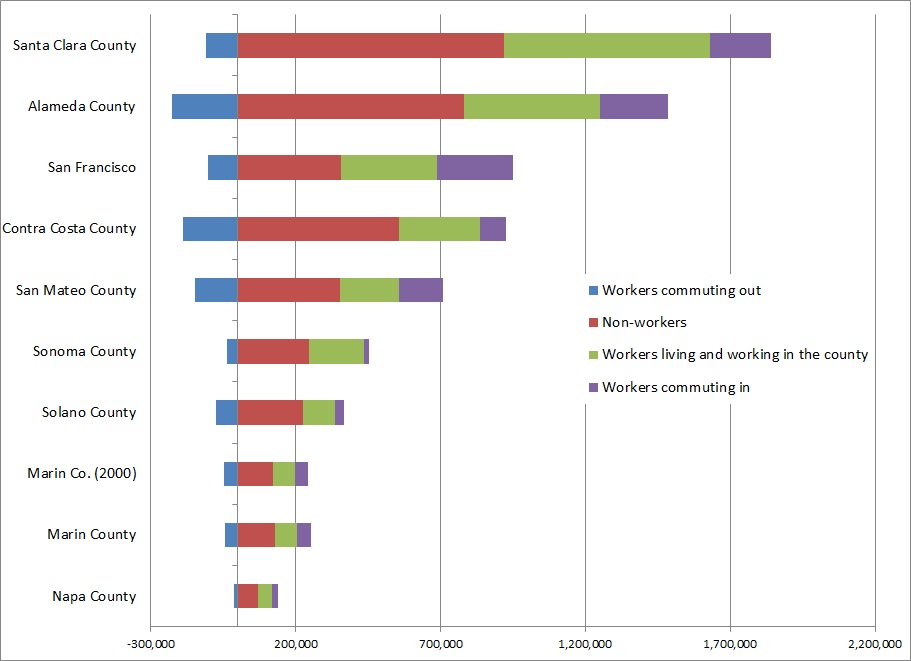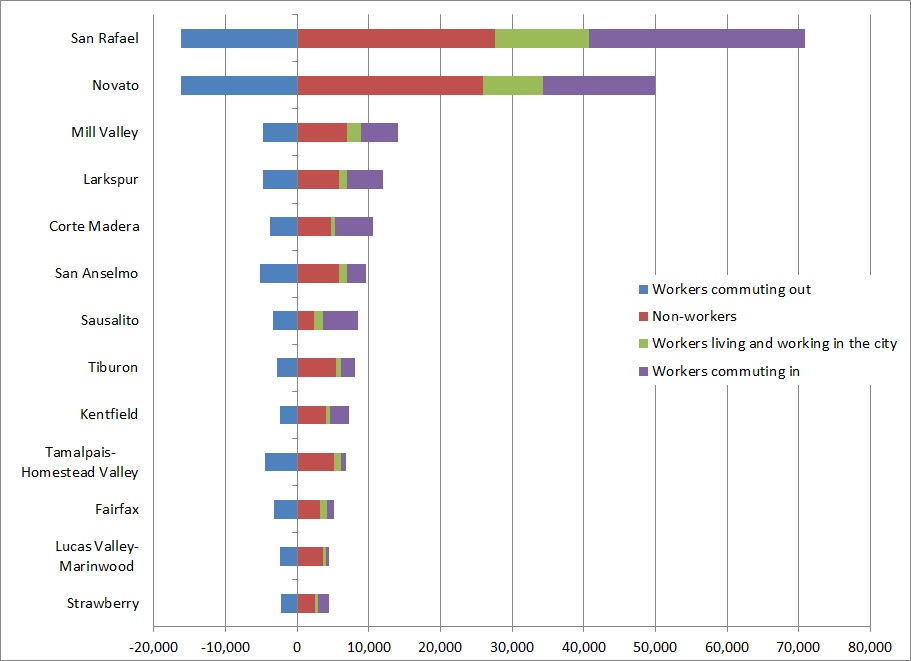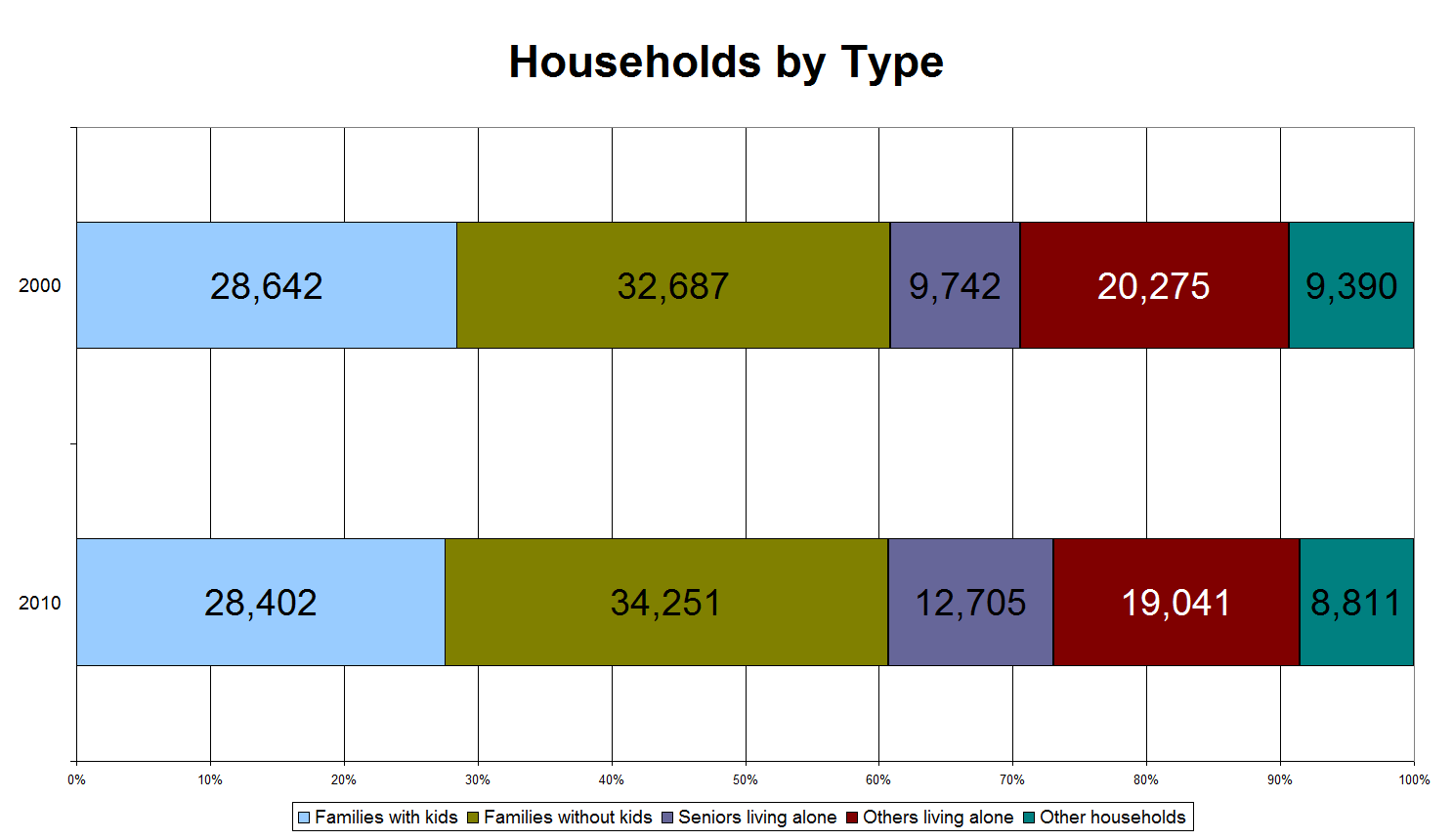Population is a statistic everyone knows about a town. It's an important stat, as it tells us how many residents there are, roughly how many taxpayers there are, how many voters, etc. However, especially for large cities, it's extremely important to know how many people are in the city during the day. Commuters swell San Francisco's daytime population to over 950,000, a fifth more than actually live there.

For smaller cities and towns, the daytime population numbers tell us how mobile people are and how much of a destination a place is. If there are a lot of workers coming in, it's an employment center. If there are a lot going out, it's a bedroom community. And if there are both a lot coming in and a lot going out, there is a mismatch between a city's jobs and its people.
The US Census Bureau ran the numbers on cities and places with a population of 2,500 or more, and the Atlantic Cities covered what the data means for big cities and regions. I'm curious about what it means for Marin.
Marin has been undergoing a transformation for the last 30 years, moving away from being a bedroom community for San Francisco and more toward being a jobs destination in its own right. Though the shift has been slow, Marin now has more jobs than workers, owing in part to a decline in the workforce and in part to an increase in jobs. The number of people commuting in has grown 3 percent; the number of people commuting out has shrunk 12 percent; and daily change in population has swung from -1.6 percent to +1.2 percent.
Data from other sources says most of Marin's 45,000 in-commuting workers live in Sonoma and Contra Costa, but we get some from San Francisco and Alameda as well. All told, these folks hold 37 percent of Marin's jobs.
There is a sense, however, that Marin is a collection of bedroom communities. While this isn't true in aggregate, every town and place in Marin sends a large portion of their workforce off to work elsewhere.
Most interesting in this regard are towns like Corte Madera, which actually grow during the day but whose local workforce overwhelming leaves the city during the day. While the place itself is a destination, the voting constituency sees its town as principally an origin rather than a destination. When asked to choose which transportation investments to make, they will probably choose the ones that will facilitate their own commute out of town rather than the investments that will facilitate the commute to their town.
Also emerging from this data is San Rafael's place as Marin's downtown. Its population grows by almost a quarter, more than San Francisco, from 57,000 to over 70,000. Novato, with a similar number of residents, doesn't change at all during the day, sending out as many workers as it takes in.
So what?
These data imply that most Marin commutes are between towns rather than between counties, as every town in Marin has more of their workforce leaving than staying while the county has a whole has more of its workforce staying than leaving. This has implications for Marin's transportation and housing planners.
First, it means transportation infrastructure investments should principally focus on short-hop transportation: bike lanes, better intra-county transit, and walk-appeal improvements. Each of these will encourage short-haul commuters to bike, take transit, walk, or any mix of those. This would leave roads and parking lots open for those who really need or want to drive.
Second, it means transportation officials should examine how to facilitate long-haul transit commutes. Morning transit from San Francisco to Marin is pitifully bad. Hour-long bus headways make sure someone is always either late or early, while Larkspur Ferry drops commuters off in the middle of a parking lot with minimal transit service. From Contra Costa, 28-minute headways are better but the travel time is longer than it needs to be. Midday headways get as high as 60 minutes.
And third, it means the linkage between housing and jobs growth is best done on a county-wide, rather than city-wide, basis. Municipal boundaries are arbitrary, and it's clear Marinites ignore them when it comes to jobs and homes. A Marin County subregion for RHNA allocations would make far more sense than the city-by-city allocations ABAG is now forced to make.
This new dataset from the Census will be extremely useful to the big cities, but it can also open a window into the behavior of our little corner of the country. Marin is maturing into a proper inner-ring suburb, drawing commuters all its own. Planners and residents need to shift their thinking, and their projects, to match that reality.
UPDATE: If you want to examine the data yourself, you can find full tables on the Census website. I've also isolated the Bay Area county data and the Marin town, city, and place data into a single spreadsheet. There have been some significant shifts since 2000 at the place level, but considering margins of error on the 2010 data I hesitate to read too much into them for the smaller places.


